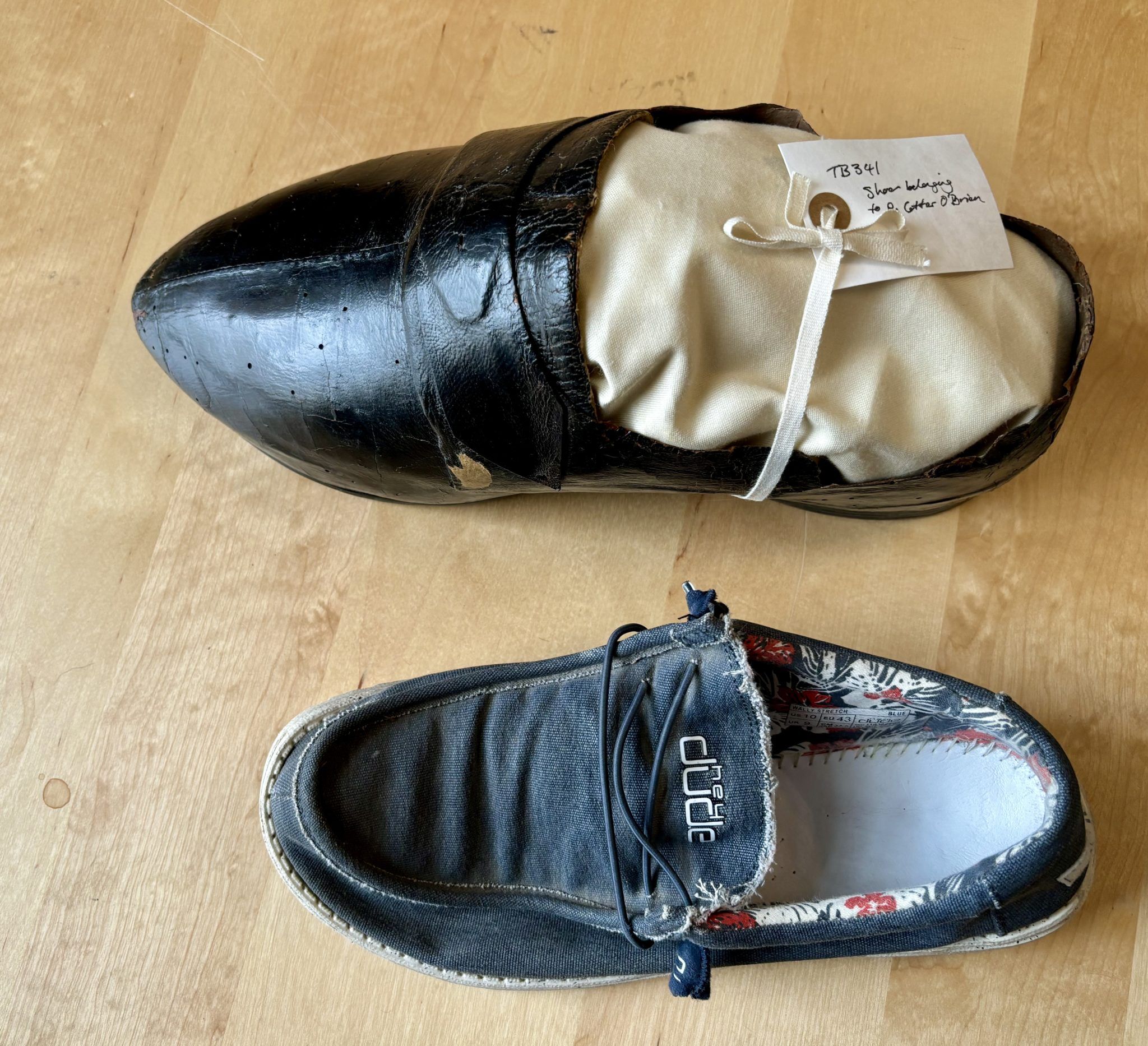This week marks 218 years since the death of a Kinsale man who towered above ordinary mortals. He was one of several ‘Irish giants’ doing the rounds in late 18th century Britain. But sources disagree about his real height ….

TOWERING above his peers, Patrick Cotter was one of several ‘Irish giants’ known in late 18th century Britain. There have been many disagreements about his height – oddities and contradictions make his life sound improbable, but reports in local newspapers and scientific examinations of his bones seem to prove his existence.
Cotter was born in 1760 (or 1761) in Kinsale itself – perhaps in the ‘Giant’s Cottage’, Chairmans Lane – or in ‘the shell of a cottage … at Belgooly, about four miles from Kinsale’ (G Frankcom and JH Musgrave, The Irish Giant, 1976). The same authors cite a manuscript in Kinsale Museum, stating that as an apprentice, aged 17, ‘he contracted a fever’ that caused his ‘abnormal growth’. Cotter’s legs grew so long that his bed needed extending.
 Cotter’s 14.5 inches long x 5.5 inches wide left shoe, compared with Robert’s size 9 shoe. Blaise Castle House Museum, Bristol)
Cotter’s 14.5 inches long x 5.5 inches wide left shoe, compared with Robert’s size 9 shoe. Blaise Castle House Museum, Bristol)
Chambers’ Book of Days states that his parents’ stature was ‘not above the common size’, although the Gentleman’s Magazine, 1804, noted: ‘Most of his ancestors on his mother’s side were very large persons.’
While employed as a brickie, Cotter plastered high ceilings at Pallastown House, and re-slated a lean-to roof in Kinsale market square without using a ladder.
A showman from Bristol spotted him, and persuaded his father to let him join one of the many ‘freak shows’, promising annual earnings of £50. On November 6th,1779, the Bristol Journal recorded the arrival of ‘the most extraordinary person for size and proportion that ever appeared in Europe’. His presence drew vast crowds.
Trouble struck when his handler let him out to another showman. Cotter asked for wages as well as food, clothing and lodging, but the showman refused, filed a charge of debt against him, and got him flung into prison. Fortunately, William Watts, a wealthy Bristol hosier visiting the prison, felt sorry for Cotter, paid off his debts, and lent him money to set up in business. By exhibiting himself at St James’s Fair, alongside a shaved bear in a chequered waistcoat and trousers, he earned £30 in three days.
The giant enjoyed Bristol, regularly attending the theatre, sitting with his back against the wall, not to obstruct other peoples’ view. Some say he also ran a pub called the ‘Giant’s Castle’. Ever the ‘gentle giant’, ‘unoffending and amiable in his manners’, he willingly accepted ‘a cheerful glass’ while playing cards.
 A cast of Patrick Cotter’s right hand, measuring 11.5 inches from wrist to tip of middle finger, compared with Robert’s 7.5 inches (at Blaise Castle House Museum)
A cast of Patrick Cotter’s right hand, measuring 11.5 inches from wrist to tip of middle finger, compared with Robert’s 7.5 inches (at Blaise Castle House Museum)
Suddenly, in 1780, he disappeared from the newspapers, perhaps returning to Kinsale. By 1783 he was back, and quickly became one of the most popular fairground attractions, claiming descent from the lofty Brian Boru.
In London, he was displayed in a canvas booth at St Bartholomew’s Fair in Smithfield. On September 6th 1791, among vendors of toys and gingerbread, was listed ‘No. 51 O’Brien – Tallman’. At Sadler’s Wells, he performed with singers and tumblers, ‘dancing dogs’ and an ‘amazing learned pig’, and could allegedly shake hands with people in the upper boxes. Using Bristol as a base, he toured Britain – from Windsor to Wakefield, Gloucester to Norwich – staying with pastry cooks, shoemakers, saddlers, watchmakers, and dozens of innkeepers, usually exhibiting himself in private apartments. In 1794, he ventured into Wales, in 1803 Scotland. He travelled in a carriage, with a deep floor ‘to hold his legs conveniently’ (EJ Wood, Giants and Dwarfs, 1868). To emphasise his height, he sometimes toured with dwarfs.
A master of self-promotion, Cotter asserted that he ‘stood on his own feet without deception’, and that even ‘the tallest man in this kingdom [was] not higher than his shoulder’. To discourage dilly-dallying, he advised that he was in town only briefly. Those of ‘quality’ could admire him in the mornings for one shilling, without fear of rubbing shoulders with working people, or servants, who were admitted for sixpence in the afternoons.
As his show depended on surprise, the giant stayed mostly indoors, and would stride through alleys at night. In Bath, he terrified a night watchman by calmly removing the top of a streetlamp to light his pipe in the flame.
On October 20th 1786, the Gazetteer made a startling announcement: ‘O’Brien … was lately married at Pancras Church, to a young woman, by the name of Cave, who lived in Bolton Row Piccadilly.’ No other source mentions a wife.
Five years later, when several newspapers reported his death, he responded that not only was he very much alive but had even grown five inches!
While the ‘Irish Giant’ was staying in Edinburgh in 1803, engraver John Kay depicted him almost nine feet tall, and witnessed he was walking with difficulty: ‘when he rose off the table, on which he always sat, his bones were distinctly heard as if crashing against one another…’ Surgeon William Blair visited him in London in May 1804: ‘He gave the impression of a huge overgrown, sickly boy… His legs appeared swollen… The feet were clumsy… to lift up his hand he seemed obliged to swing the whole arm…’ Later that year, crippled by osteoarthritis, he retired from public life.
As with many exceptionally tall people, Patrick Cotter died young, his cause of death: ‘disease of the lungs combined with an affection of the liver’. Most sources report him succumbing on September 8th, 1806 in Bristol. Others claim he died in Epping Forest, or Gainsborough. One even has him suddenly being taken ill and dying in Cork on August 3rd 1804 – aged 39.
In his will, he left £100 to the Kinsale Roman Catholic charity school, and £2,000 to maintain his mother, Margaret – who lived until 100. Other relatives in Kinsale were remembered, and provision made for a child in his mother’s care. A mariner called Donovan received Cotter’s diamond breast pin, silver shoe buckles, and ring – reputedly the size of a curtain ring. To Mr Watts, who had rescued him from prison, he bequeathed two houses in Bristol, and his weighty gold watch and chain.
Fearing his body was coveted by anatomists, Cotter requested undertaker Joseph Panting to enclose it in three tightly-sealed coffins. His funeral on September 13th, at St Joseph’s Church, Trenchard Street, was arranged at 6am to avoid gawkers. Nevertheless 2,000 people packed the narrow street. ‘More like a rowing boat than a coffin’, the casket took 14 men to lift it. The plate read: ‘PATRICK COTTER O’BRIEN of Kinsale, Ireland, whose stature was 8 feet 4 inches. Died September 8th, 1806. Aged 46 years.’ The ‘stupendous’ coffin was lowered into the shaft – cut 12 feet deep from solid rock – and the grave sealed with concrete, strengthened with iron bars.
His servant, Mr J Wilds, made a wax model of Cotter, dressed it in his outsize clothes, and displayed it at Mr Knight’s stocking factory in Bristol, before taking it to Bath and London.
The giant’s grave remained undisturbed until 1906, when workmen were laying drains. Professor Edward Fawcett from Bristol University, who was called on to examine Cotter’s bones, described ‘the enormous development of the face’, and the ‘enormously enlarged’ pituitary. In 1972, when his remains were exhumed again before being cremated, his height was calculated as 8 feet 1 inch.
Several of Cotter’s possessions still survive, including two thick gloves, a black leather shoe, a pair of steel-rimmed glasses, a mahogany chair, and a lock of light-brown hair.
One item, though, is lost forever: a diary which Patrick tossed on the fire. He ‘much regretted the circumstance’. So do we.
• Thanks to Lee Hutchinson, curator, Bristol Museums, for providing access to artefacts in the reserve collection at Blaise Castle House Museum.







